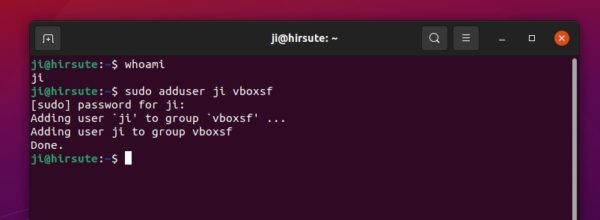

- VIRTUALBOX SHARED FOLDER UBUNTU ACCESS DENIED HOW TO
- VIRTUALBOX SHARED FOLDER UBUNTU ACCESS DENIED INSTALL
- VIRTUALBOX SHARED FOLDER UBUNTU ACCESS DENIED PASSWORD
- VIRTUALBOX SHARED FOLDER UBUNTU ACCESS DENIED WINDOWS


Are you using a valid username and password? Does that account really have access to this folder?ĭo you have whitespace in your credentials file? It should be password=mspassword, not password = mspassword.ĭo you need a domain? For example, if you are told that your username is SALES\sally, then actually your username is sally and your domain is SALES.If you get the error "mount error(13) permission denied", then the server denied your access. With this in place, users can create their own ~/.pam_. Gksudo gedit /etc/security/pam_įirst, we're moving the user specific config bits to a file which users can actually edit themselves: remove the commenting tags () surrounding the section called.
VIRTUALBOX SHARED FOLDER UBUNTU ACCESS DENIED INSTALL
Install libpam-mount: sudo apt-get install libpam-mountĮdit /etc/security/pam_ using your preferred text editor.
VIRTUALBOX SHARED FOLDER UBUNTU ACCESS DENIED PASSWORD
Your username and password are the same on the Ubuntu machine and on the network drive. In addition to the initial assumptions, we're assuming that Mount password protected shares using libpam_mount (Ubuntu 9.04) servername/sharename /media/windowsshare cifs uid=ubuntuuser,credentials=/home/ubuntuuser/.smbcredentials,iocharset=utf8 0 0 If you need special permission (like chmod etc.), you'll need to add a uid (short for 'user id') or gid (for 'group id') parameter to the share's mount options. Your remote share should mount automatically. If there are no errors, you should test how it works after a reboot. servername/sharename /media/windowsshare cifs credentials=/home/ubuntuusername/.smbcredentials,iocharset=utf8 0 0įinally, test the fstab entry by issuing: Then edit your /etc/fstab file (with root privileges) to add this line (replacing the insecure line in the example above, if you added it):
VIRTUALBOX SHARED FOLDER UBUNTU ACCESS DENIED WINDOWS
Using a text editor, create a file for your remote servers logon credential:Įnter your Windows username and password in the file:Ĭhange the permissions of the file to prevent unwanted access to your credentials: This is a file that contains just the username and password. The way around this is to use a credentials file. This is not a good idea however: /etc/fstab is readable by everyone and so is your Windows password in it. The quickest way to auto-mounting a password-protected share is to edit /etc/fstab (with root privileges), to add this line: //servername/sharename /media/windowsshare cifs username=msusername,password=mspassword,iocharset=utf8 0 0 This will (re)mount all entries listed in /etc/fstab. If there is any space in the server path, you need to replace it by \040, for example //servername/My\040DocumentsĪfter you add the entry to /etc/fstab type: sudo mount -a This doesn't work with shares of devices like the Buffalo Tera Station, or Windows machines that export their shares using ISO8895-15. Iocharset=utf8 allows access to files with names in non-English languages. Uid=1000 makes the Linux user specified by the id the owner of the mounted share, allowing them to rename files, Guest indicates you don't need a password to access the share, Then edit your /etc/fstab file (with root privileges) to add this line: //servername/sharename /media/windowsshare cifs guest,uid=1000,iocharset=utf8 0 0 You will need a separate directory for each mount. Mounting unprotected (guest) network foldersįirst, let's create the mount directory. You want to mount the share in /media/windowsshare. The Windows computer's name is servername (this can be either an IP address or an assigned name). Share password on Windows computer is mspassword. Share username on Windows computer is msusername. Your local (Ubuntu) username is ubuntuusername.
VIRTUALBOX SHARED FOLDER UBUNTU ACCESS DENIED HOW TO
(This document does not describe how to host the shares yourself, only how to access shares that are hosted somewhere else. This document also applies to SMBFS shares, which are similar to CIFS but are deprecated and should be avoided if possible ( link). The shares might be hosted on a Windows computer/server, or on a Linux/UNIX server running Samba. This document describes how to mount CIFS shares permanently.


 0 kommentar(er)
0 kommentar(er)
